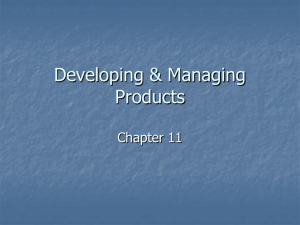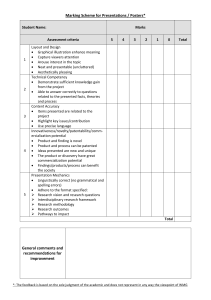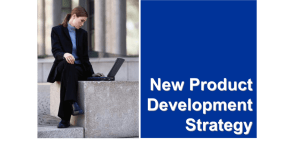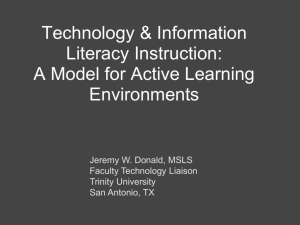The Role of Knowledge Management in the Organizational Innovation Roberto Evaristo, Ph.D.
advertisement
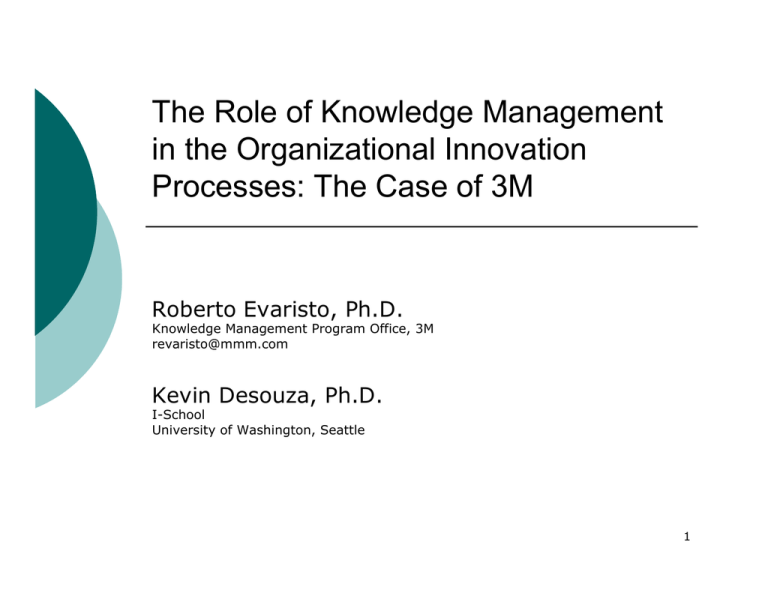
The Role of Knowledge Management
in the Organizational Innovation
Processes: The Case of 3M
Roberto Evaristo, Ph.D.
Knowledge Management Program Office, 3M
revaristo@mmm.com
Kevin Desouza, Ph.D.
I-School
University of Washington, Seattle
1
Innovation is difficult
{
One of the most difficult challenges in Innovation:
Black Box Approach
z
z
z
{
Every company understands the importance of innovation.
However, innovation remains a black box.
No one knows how to manage black box processes.
“Innovation is a must to survive in our
environment.…All of my [executive] colleagues
understand the need for innovation and are 100%
supportive of employees who innovate.…Yet, I cannot
say that we have an organizational process for
innovation…Innovation happens, but I cannot outline
the process to you because I do not think we have
one.”
– CEO, Information Technology Organization
2
Driving Questions
{
{
{
What are the stages of the innovation
process in organizations?
What are the various issues that
organizations face?
What are the differences between
organizations with mature innovation
processes and those with immature or
nonexistent innovation guidelines?
3
Innovation Process: 5 Major Stages
Generation
Mobilization
Advocacy
Screening
Experimentation
Commercialization
Diffusion
Implementation
4
Generation and Mobilization
{
Idea Generation:
z
The process whereby new ideas are created through
{
{
{
{
{
Mobilization:
z
{
The stage where modifications to any existing products, processes, services
or frameworks of thought lead to the movement of ideas from one location
(physical or logical) of the organization to another.
Idea sources may be:
z
z
{
Redefinition of concepts
Changes in processes
New components of products and service
The offering of brand new products and services
Internal
External (e.g. customers, business partners, academia, government, or
competitors)
Some ideas may be created from scratch; some others transported
from allied or foreign domains
5
Maturity Indicators
{
Organizations with mature innovation programs
a)
b)
c)
d)
e)
{
Have clearly articulated guidelines to help in the recognition and
construction of ideas.
Find a balance between emphasizing play and emphasizing
need.
Are more likely to explore ideas from a wide array of sources
and open to ideas no matter where they originate
Know how to connect sources of ideas and nurture ideas from
sources.
Hold some people, teams or units responsible for idea
generation.
Immature organizations are more likely to seize good,
immediately applicable ideas, but not to reward sources for
ideas, or ideas that complement the direction of the
organization without being immediately applicable.
6
The case of 3M
{
{
{
3M is a company where close to 50 different technology platforms coexist to synergistically create over 60,000 different products in areas
as diverse as abrasives and biotechnology, medical care and
adhesives, solar energy and mining, electricity and drug delivery, light
management and acoustics (and much more)
Cross-pollination of ideas across platforms has historically been one of
the sources of innovation in the past – and also of competitive
advantage.
Multiple avenues to help serendipity:
z
z
z
{
Tech Forum
E-Tools
COPs
Examples:
z
z
z
z
z
z
z
Wet-dry sandpaper /Masking tape
Scotchgard™ in oil wells
New paper cutter
Post-it picture printing paper
“Nomad” ™ carpets in mining
Anti-dust applications
Low-weight ceramic electrical cables
7
Advocacy and Screening
{
{
{
The process of identifying the potential benefits
and problems with any particular idea at a
particular time
Advocacy and screening encompasses evaluation
of potential opportunities and allows ideas to
undergo a period of refinement.
To increase the likelihood of success, both
advocates and screeners must be present in an
organization and have the collaborative skills to
interact productively.
8
Maturity Indicators
Organizations with mature innovation programs
{
a)
b)
c)
d)
e)
f)
g)
Have clear-cut protocols for the evaluation and
screening of ideas.
Know how to balance appropriately between immediate
and longer term ideas.
Know how to advocate and screen for ideas that have
varying degrees of impact.
Let their employees have numerous avenues through
which to advocate for and get feedback on their ideas.
Recognize that advocating for ideas is a risky and timeconsuming process.
Provide rewards to those who advocate for ideas in
addition to rewards and recognition for idea generators.
Take great care in building transparent evaluation and
screening protocols.
9
The case of 3M
{
{
{
{
{
{
{
Idea hopper with 6-sigma tools to evaluate best candidates
for further analysis
Record of invention
Internal selling process (intrapreneurial)
15% time available to foster innovation
Idea champions critical to the process
Feedback along the way is easily available; culture is strongly
open to sharing and supporting each other’s ideas.
R&D is taken very seriously
z
z
{
At heart, 3M is an engineering company
Basic science vs. applied science
Different awards and recognitions supporting the evaluation
process
10
Experimentation
{
This process determines which ideas are
technically and structurally possible at the
present.
z
z
z
{
An iterative process
{ At each stage of the experimentation
process an idea must be re-evaluated by
advocates and screeners alike.
Experimentation can be resource-consuming.
Experimentation is an unstructured process.
Major outputs:
z
z
Identification of ideas for commercialization
Libraries of ideas not being pursued
11
Maturity Indicators
{
Organizations with mature innovation programs
a)
Encourage experimentation.
b)
Have identified ways to creatively use
technology.
c)
Have a sanctioned process for experimentation.
d)
Have a clear and known process by which a
prototype is constructed, tested, evaluated,
refined, and improved upon.
e)
View the experimentation process both as a
necessity and as an asset.
12
The case of 3M
{
{
{
{
{
Best ideas are evaluated for moving from lab to
production (scale up)
Complete set of labs: division labs for product
development, process and material labs to
support scale-up for manufacturing
Products can be killed in this stage
Prototype manufacturing lines are available for
experimentation in small volumes
Intellectual property carefully kept (both for
successful ideas as well as those not pursued)
13
Commercialization
{
{
{
The commercialization process focuses on the potential
impact of an idea.
During this stage, ideas are packaged into products
and/or services that have internal or external market
value.
Part of the work of commercialization is to establish the
specifications of an idea.
z
{
The promises and potentials of the earlier stages of
innovation must be discarded so that the actual benefits
of the new innovation can be perceived and
communicated.
Documentation, both of the commercialization process
and of the demonstrable and communicable aspects of
the innovation, becomes crucial. The very act of
documenting an innovation’s benefits establishes a
base for communicating value.
14
Maturity Indicators
{
Organizations with mature innovation programs
a)
b)
c)
d)
Are more likely to be able to package their new
ideas within existing products and services
without disrupting current customers, services or
offerings.
Understand the difference between idea creation
and idea commercialization.
Have clear and robust linkages between
experimentation and commercialization efforts.
Experiment frequently with minimal cost.
15
The case of 3M
{
{
{
{
{
Stage gate process based on 6-sigma processes
has been implemented for new product
development and introduction
Ancillary systems provide support for the whole
process
Training is available for all appropriate
stakeholder levels
Commercialization of a given product is done by
multiple divisions
Typically products sold through wholesalers or
other intermediaries; however, sales force is very
strong in its interaction with ultimate users to
influence their choice / specification of 3M
products
16
Diffusion and Implementation
{
{
{
Diffusion is the process of generating buy-in and acceptance for a new
innovation.
Implementation is the process of setting up the structures,
maintenance and resources to allow the innovation to develop and be
utilized or produced.
3 useful strategies for diffusion of ideas:
z
z
z
{
Targeting key actors to align the company for knowledge management
Building on existing initiatives and actively focusing on knowledge networks
to generate momentum
Communicating a purposeful message that aids the cultural and mental
transition
Knowledge Brokers
z
z
z
Key figures who bring new ideas to the table within an organization or as
representatives of a partner company or outside organization
They know the specific context and application.
Using knowledge brokers is an effective way to formalize and systemize this
stage of innovation.
17
Maturity Indicators
{
Organizations with mature innovation programs
a)
b)
c)
d)
e)
Know how to enable change.
Are likely to turn back to the social networks
developed during earlier phases of innovation.
Are likely to have already established customer
segmentation policies that helped drive the earlier
screening and prototyping stages.
Use technologies to enable the diffusion and
implementation process.
View the implementation and diffusion process as
an opportunity to identify next set of needs for
customers.
18
The case of 3M
{
{
{
{
Social network analysis is utilized to understand
interactions among large number of scientists, sales
force, and other key stakeholder groups
Strong informal networks do exist; they are supported
by many formal structures in the R&D,
Commercialization, and Manufacturing segments of the
business
Very frequent workshops are available: new
technologies, opportunities or just courses spreading
technical state of the art are common (i.e., web
handling, vacuum processing, etc.)
Worldwide asynchronous poster sessions detailing
innovative solutions are held multiple times a year;
replication of these in different geographical or area
markets are encouraged.
19
Conclusion
{
The innovation process is:
z
z
{
{
the backbone against which innovative efforts can
take shape.
The context around which ideas are mobilized from
thought to action.
All ideas must go through the entire innovation
process.
In many cases, having a sanctioned and
organization-wide framework for innovating may
be a strategic competitive differentiator.
20
Questions and Comments
Roberto Evaristo, revaristo@mmm.com
21
